Update On The Basement
(We're back on a weekly posting schedule. I've been helping move an elder family member to another state, which is the reason for my lack of blog posts. The laptop I took with me decided to be a bitch about my files. I had to wait until I got home to access them.)
Time to update everyone on my progress in the basement. It's really coming along. Just to familiarize everyone, this is the first phase floor plan.
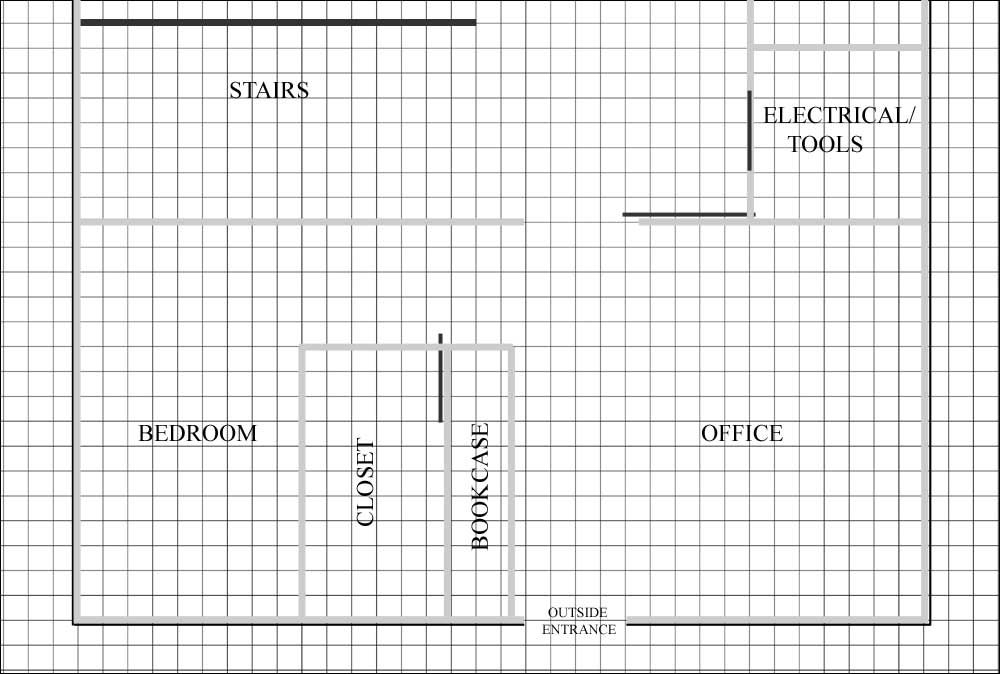
You probably remember some of the earlier blog posts. Here's the picture of the staircase modifications to add storage. I've been focusing on the living space at the moment, trying to get it finished enough to move in. It does though need to be done enough that I'm not generating dust or paint, because of the cats who will be joining me there.
.jpg)
The storage shelf and freezer platform are mostly holding tools and stuff at the moment. I'm running basic wiring and will have a licensed electrician hook me up at the breaker box. I expect to need 4 new lines run into the box. Two at 20 amp and two at 15. I haven't yet moved the freezer because of that.
You can see in this photo that I'm moving the heat/AC vent output into the living area. Below the arrow is the new vent. The wall not yet drywalled will be getting an extension so the main door slides in and secures. More on that in a moment.
Here is the entrance to the office from the larger part of the basement.
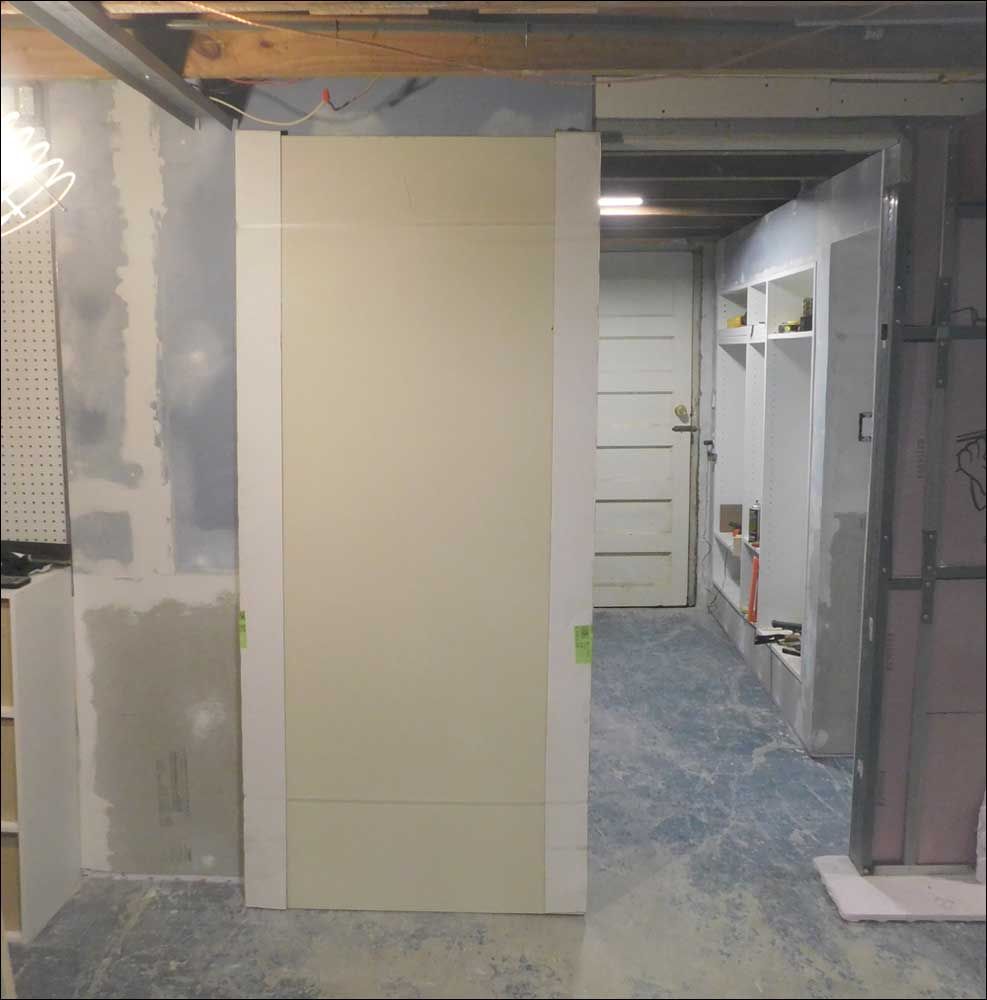
I wanted the doorway to be as large as I could to allow me to move things in with ease. That is a 32" wide doorway, with a 36" door. I got the doorway a little too tall though. I'm using one of the newer stylish sliding barn-type doors rails. The hardware isn't installed yet. Thought I would need to cut the door down a few inches but now I'm going to need to add a rubber cushion on the bottom so there isn't an air gap at the top. I was going to do that to prevent air leaks anyway. The area just above the doorway has not been covered with a piece of finish drywall, that's why it looks different.
The door is on a slight incline, lower on the right of the picture. I will be making a receiving pocket on the right, so the door slides in an inch or so. This will make a small out step, which will have the heat/AC duct inside of it. I had two choices, either offset the bedroom and office wall from each other or make this pocket. Since the ceiling headers ran in line with the wall, I decide on this as the better option.
The steel stud track in the left at the top is the wall of the electric breaker box and tool room. I expected that I would need a pocket for the main office door in it as well, so I left it uncut. Here is that room.

I like the flexibility of the canvas cubes for storage. And working at the big box hardware store I can get them when they go on sale. I'm also a fan of pegboard, lol. This room will have common tools and supplies we use on a regular basis, while the workshop area in the second part of the basement will have a much bigger selection of tools and workbenches. Once the freezer is swapped out for my larger one and moved to the stair storage, I have a tall bookcase that will go in its place.
The direction of the main sewer stack access is a problem. I will have to have a removable wall section between the electrical/tool closet and the larger one next to it. Since we have never had to have that snaked I don't see it being a problem as long as I can open it up if needed.
The four electrical socket box is for the computer internet server. At the moment it is in my sister's bedroom closet. I prefer to hardwire my desktop PC, not use wi-fi. I'll put a small shelf up there for it. At some time in the future, I'm going to a professional server since I also plan on installing security and exterior camera system.
And yes those are foam pool noodles in the corner. I'm covering the hot and cold water pipes with them to conserve energy. I prefer pool noodles to the black ones you can buy in plumbing, since you can get them cheaper, and they can be color-coded for each temperature pipe.
Let's enter the office area. Going around the room we have the doorway wall,
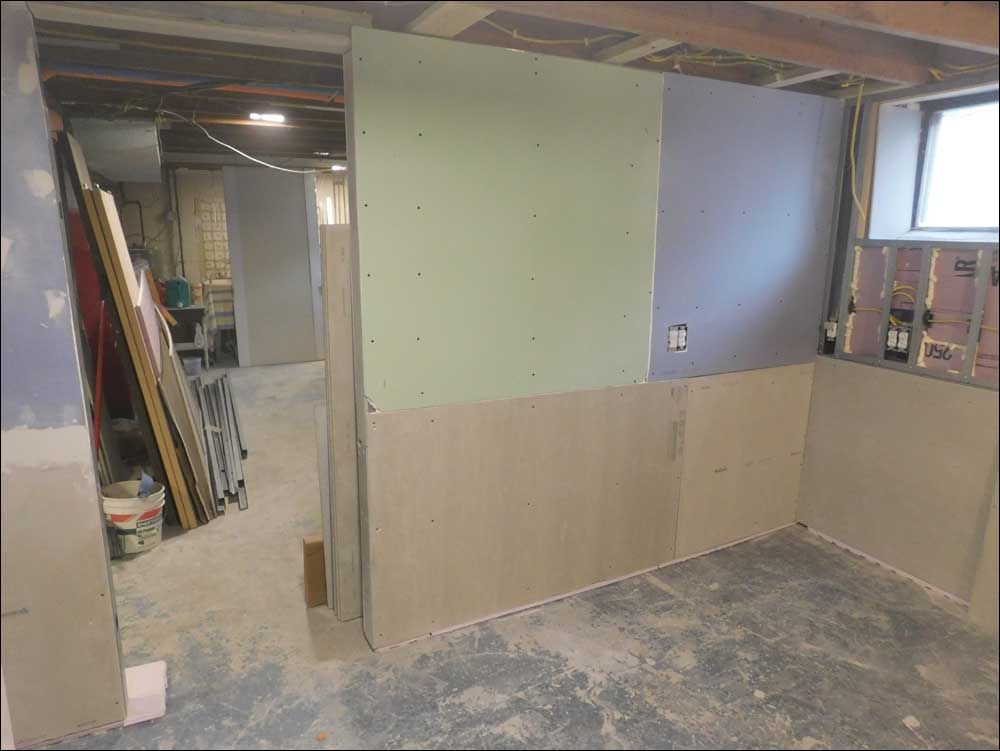
Desk corner and window. For being in a basement it has huge windows. Should give me some natural lighting.
The single outlet on the left wall has the switch for the overhead working lights. Yes, I have thirteen outlets on the window wall, but it's going to be a 20 amp run. I figured it was better to have hard-wired dedicated outlets for all my computer equipment than a couple of outlets and a bunch of power strips. The danger is any single electrical line pulls too much amperage and overheating to catch fire. All my electrical is wired with the heavier 12/2 line, in the event I decide to upgrade later. There are three dimmable 8-watt led pot lights in the ceiling over that corner, and another in front of the whiteboard. This gives me focused lighting to work by which I can lower when I'm not needing lots of light, while the larger main light over the center of the room can be used if I need to enter or to work in the entire room.

Whiteboard wall and cat corner. I plan a pretty large wall-mounted gymnasium for the two cats, so they can climb up, walk over and sit in both the office and the bedroom windows.

This is going to be a working office so I'm installing a 32"x48" three-layer whiteboard at the place the first piece is sitting, only it will be on the top of the wall. There will be two layers as large which will slide into the wall in a pocket. Gives me more flexibility to write stuff. The electrical outlet and water pipes on that wall will be covered. The outlet will have the sockets removed and the wiring capped. The kitchen sink drain pipe has access for cleaning. I will have to install a removable panel there as well.
That's the exterior entrance to the right. I plan to switch the hinge side on the exterior door in the future. So it swings toward the bookcase. As it is when you try to bring long pieces of wood or board down, the door restricts the space you have.
And here is the inset bookcase and entrance to the bedroom.

Yes, the doorway to the bedroom has a very low ceiling. The heat/AC ducts go through that section. You don't have to duck but it's tight if you are taller than 6 feet. It too has a pocket door for privacy, set into the back of the bookcase/closet space. You can see the large vent I'll now output the heat/AC to the living area to the right and up on the wall in the doorway.
Now for the bedroom. this is the other side of the doorway.
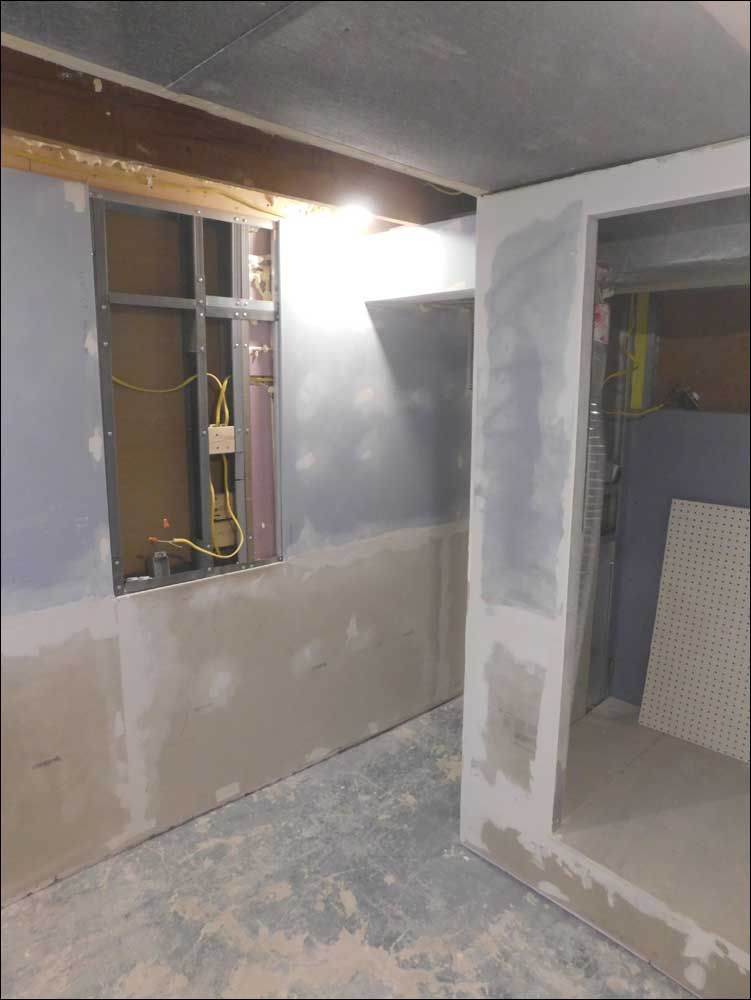
You can see the closet to the right. I'm working on the electrical in the open section of the wall. I've had a chance to lay a couple of coats of drywall mud on cracks and screw heads.
The area for the bed.
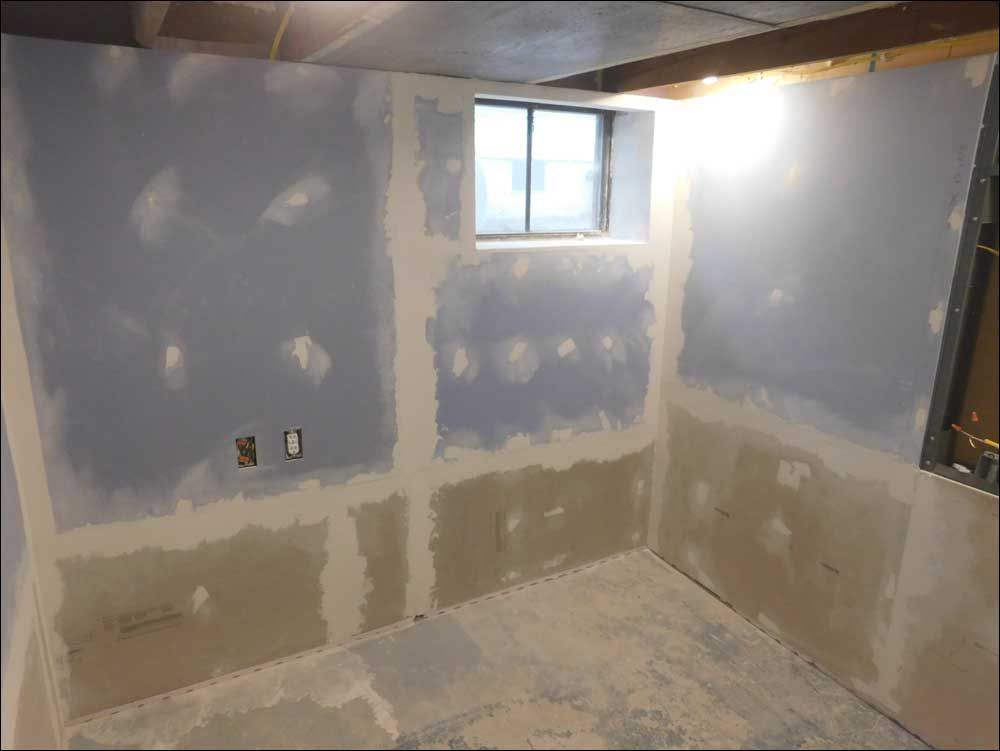

I'm insulating the ceiling joists but leaving them exposed to give the illusion of more ceiling height. The ceiling will get dark brown paint down to the tops of the drywall. Then I have crown molding which will provide visual separation. Walls and molding will be a basic white. I'll probably go with a typical heavy traffic basement grey for the floors.
The bedroom got three dimmable led 8-watt pot lights, two above the doorway wall and one over the bed on the opposite wall. Didn't feel like I needed a larger main light since when you turn them up fully it is quite bright in the small space.
One thing that is bothersome, is the bedroom has a large air return in the ceiling there. That's the sheet metal panel at the top of the picture attached to the ceiling joists. But it's the bedroom, not a space that will get lots of visitors.
The closet,

Yes, it's quite large. I chose to put my dresser space and shelving in the closet as a way to maximize the space in the bed area. Pegboard again on the top half of the walls. I like pegboard in closets as a way to add and change hooks or other ways to store things that don't lend themselves to shelves or drawers.
the opening in the upper right of the photo is for accessing the exterior water faucet. I wanted something sizable in case I had to have it replaced in the future. It gets a door over it.
Here it is inside of the closet.

You can see the heat/AC duct inside the closet. At the lower point of the left front, near the floor is an air return. I do not have the hole cut in the drywall yet, so to cut out any chance of dust getting into our furnace.
I made a mistake and used 1 5/8" steel wall studs for the closet wall. That meant I will have to add some depth in the right corner so I can install the box for the light switch. You can see the height of the drywall on the inside of the closet behind the air return duct. Above that will be pegboard. Once that is installed, I'll tie off the duct to the wall and install a tall set of drawers next to it.
----
I'll leave the update there for now. More to come.
Comments
Ken
Mon, 03/21/2022 - 18:57
Permalink
Wow! You are really transforming that space!
What some non-former sheetrockers may not recognize in these pictures is that every single piece of sheetrock had to be humped down into the basement, cut to fit, installed and the waste pieces carried back up the stairs. And sheetrock is HEAVY!
Are you planning to use throw rugs on the floor? I've found that, as I get older, I nearly always wear slippers in the house, even to go down the hall to the bathroom in the middle of the night. A friend that is an accupuncturist of the 5 Elements school, told me that as we age it is important to not let our feet get cold; basically wear slippers or warm socks whenever the floor is cold. So maybe an investment in a nice pair of comfortable slippers is in order?
I wonder about ventilation in a basement? I'm claustrophobic myself and would go crazy without being able to have cross ventilation and opening windows in every room. Urban folks that are used to offices maybe have already gotten past that issue? I'm a country mouse but I get it that not everyone shares my sentiments.
David Trammel
Mon, 03/21/2022 - 21:27
Permalink
Some Advantages Downstairs
First I have an exterior entrance so I only have to go down 4 stairs. And having a pickup that I can back up into the driveway next to the entrance, and cut my drywall outside, means I don't have to lug full sheets downstairs.
The basement is about 4 feet out of the ground. That means I have two huge windows on either side of the house, and if needed can pop the windows open and get cross ventilation. They both have screens, which is a must because the cats are getting extensive cat towers next to each window, and the window ledges themselves have been extended, so they can look out and watch life go by.
The downside is that the first 3 feet of all the walls are cement fiberboard. I wanted no chance of any sewer backup affecting my walls and causing mold. Still, the 3x5' boards are heavier than 4x8' drywall. The drywall above that is moisture-resistant stuff. It's made getting the studs lined up a challenge. I'm way above code with studs typically 12" center to center.
I am going to have a couple of small rugs, but I typically wear socks when I'm lounging. Yes, my feet are my downfall. They get cold and I'm miserable.
I'm over in the kitchenette area at the moment, and I'll post a couple of pictures tomorrow of that.
Ken
Wed, 03/23/2022 - 16:58
Permalink
Good thinking
Flooding is the bane of sheetrock. You are wise to put water resistant stuff and non-absorbent insulation in the lower part of your walls. A friend who lives in Houston was flooded this last massive rain dump, despite being in an area that is safe from rainfall accumulation, because there is a dam above the area that had to be opened to prevent catastrophic failure of the entire dam structure. In other words, man-made stupidity flooded his house, not nature. Similar story to New Orleans with Hurricane Katrina. He had only a foot or so of water in his house and yet remediation required nearly a year of camping in the house with mold and bare studs. Wood floors, drywall, trim, insulation, cabinetry, wiring, etc. - all ruined. And every contractor for a thousand miles was booked solid for months if not years... The moral of the story is: it only takes a little water to ruin your house!
re: cold feet
I have had good luck with glue down cork flooring. It's only about 1/8" thick but it provides a resilient surface to walk on and it's surprisingly warm, at least compared to a concrete slab! Just a thought; it's non-toxic, sustainably grown (leftovers from wine cork production), relatively easy to install and it is available in a wide variety of patterns. AND it's waterproof (keeps the wine in the bottle, right?). The one downside is it dents under chair legs and other pressure points. It does bounce back with time. The stuff I got was in "planks" roughly 1' x 2' so it went down like tile. I haven't priced it in years, but 15 years ago it was about the same per square foot as low end wood flooring (red oak shorts).
re: ventilation
I'm breathing easier knowing that you have some opening windows and an outside door!
pygmycory
Tue, 03/22/2022 - 17:06
Permalink
that's quite the impressive project
I hope it keeps going well for you.